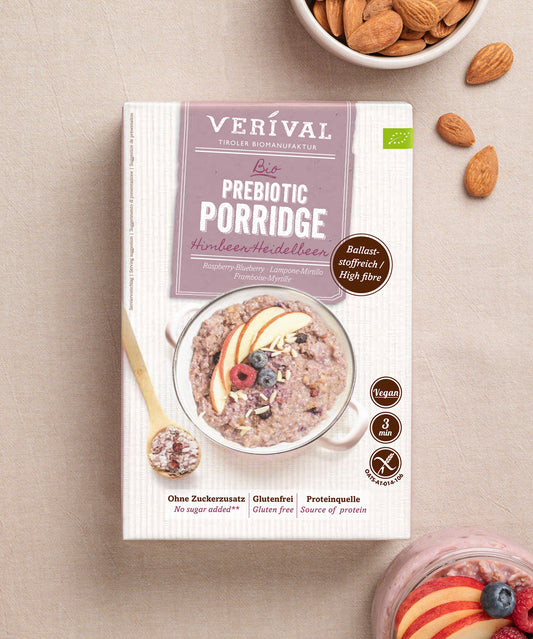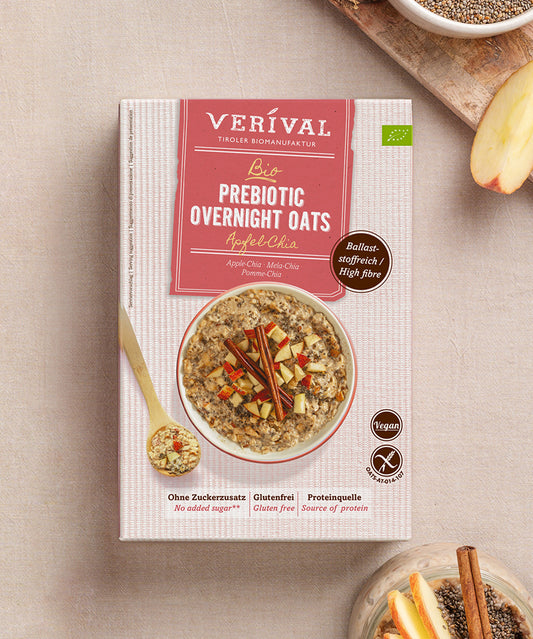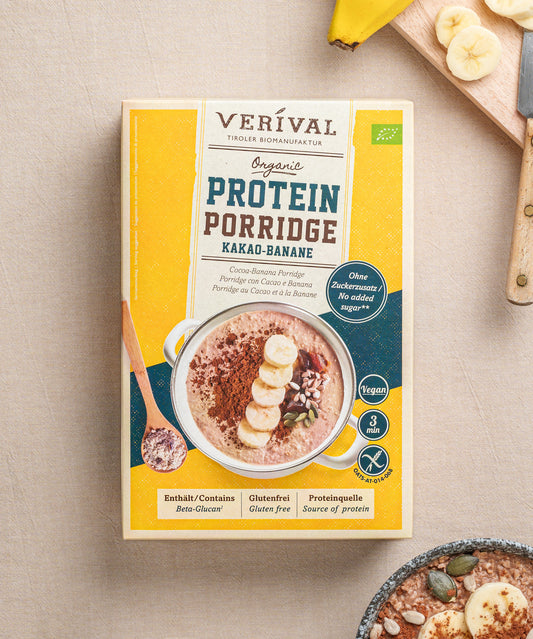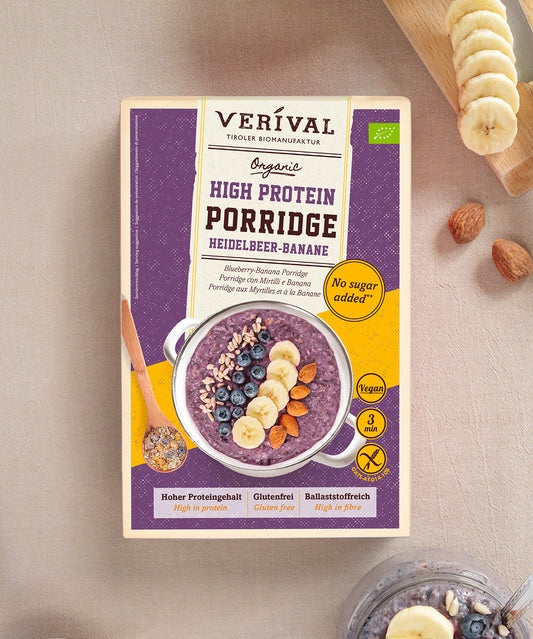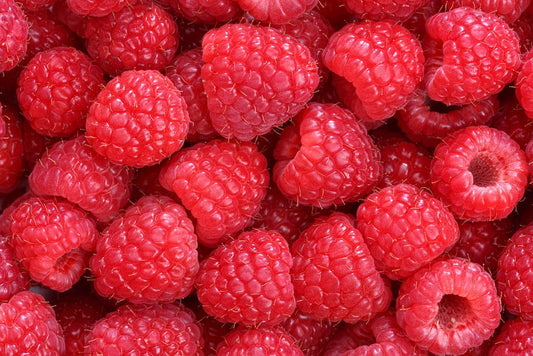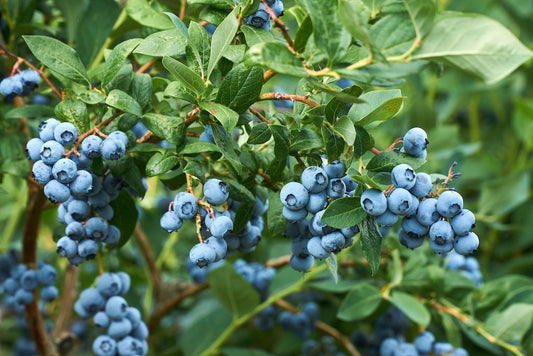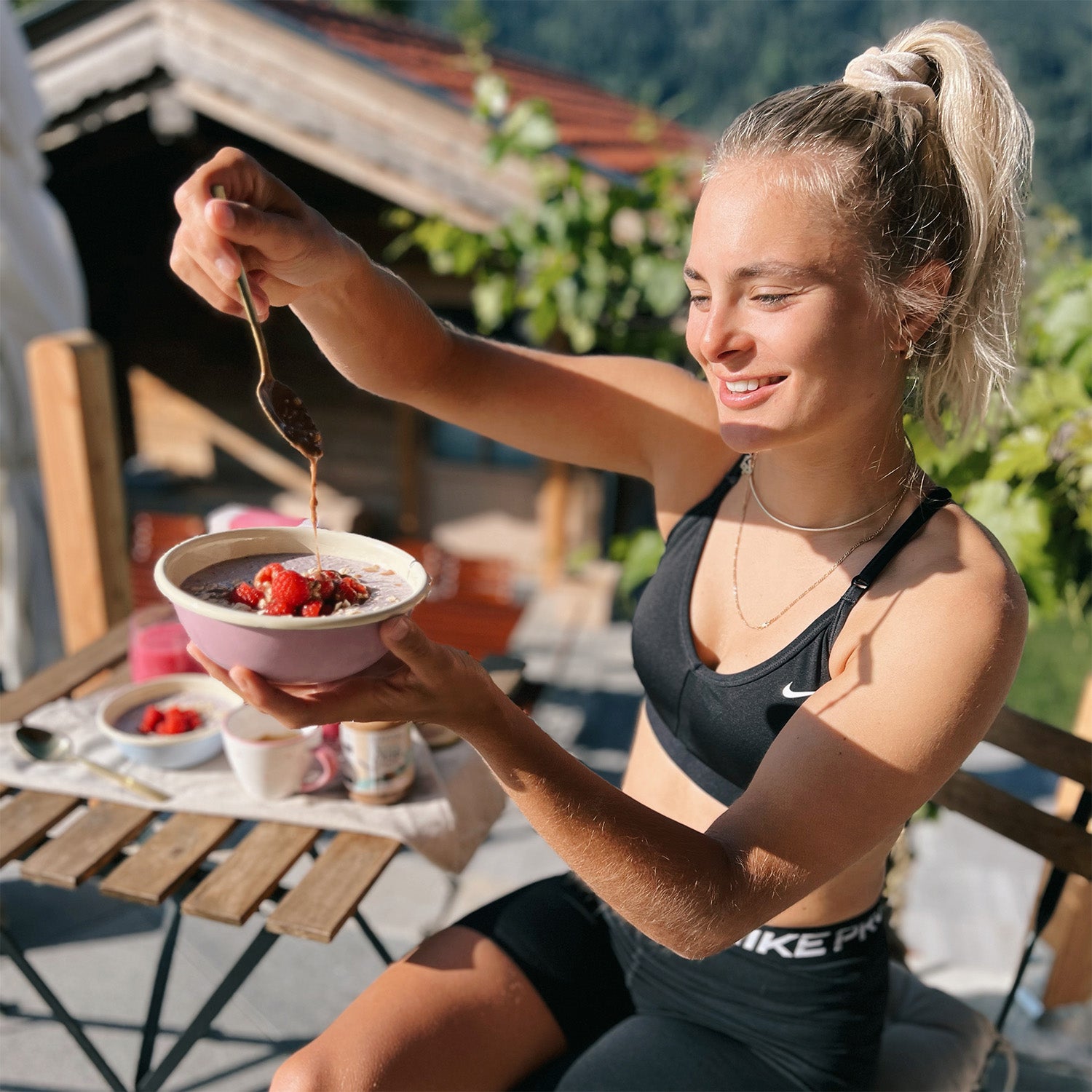According to the Austrian Nutrition Society, you should ideally eat 5 portions of fruit and vegetables a day. Some people tend to reach for fruit varieties, while others prefer to eat more vegetables to meet their daily requirements.
But what is really healthier and should you eat more fruit or vegetables?
In this blog post, we will explore this question and also clarify where the differences between fruit and vegetables lie and whether there are any differences between the two at all.
About the Verival breakfast products
Fruit vs. vegetables – what are the differences?
Let's start with the question of what the differences are between types of fruit and vegetables. How can the two be distinguished? What makes an apple a fruit and a pumpkin a vegetable?
In science, there is no clear differentiation between fruit and vegetables. This is mainly because there are so many exceptions and because a food does not fit into the category because of one characteristic, for example. Even food scientists therefore have no clear definition of what is a fruit or vegetable.
However, there are many indications that suggest whether a food is more of a fruit or a vegetable:
- Fruit is mainly eaten raw, while vegetables tend to be cooked or at least steamed. However, there are exceptions to this rule, such as apples, which also taste very good when warm in the form of apple rings or apple strudel.
- However, there are also vegetables, such as carrots or celery, that can be eaten raw. But why is fruit more often used as a raw vegetable? On the one hand, the higher sugar content is responsible for this, and on the other hand, it is because ripe fruit is usually soft and can therefore be chewed well raw. Vegetables tend to be hard and therefore difficult to chew.
- Fruit is usually sweeter than vegetables. In addition, vegetables tend to be prepared in a savoury way.
- Fruit tastes rather sweet to sour. Vegetables, on the other hand, don't have such a strong taste of their own and can therefore be seasoned well. They are ideal for cooking.
- Another difference is the average water content. Vegetables often have a content of up to 80%, with cucumbers even having 97%. In comparison, fruit has a lower water content. For example, bananas only have a water content of 75%.
What are the botanical differences between fruit and vegetables?
We have now learned about the differences that are relevant to each of us and that we also notice in our daily lives. However, there are other important distinguishing features in botany.
- One major difference between fruit and vegetables is the length of time that the plant remains. Fruit is usually a perennial plant. The fruit grows on trees or shrubs and can be harvested every year. In contrast, vegetables are harvested once per season and the plant then dies after one season or one year. The vegetables have to be grown again the following year. Asparagus, for example, is an exception. A seasonal calendar for the different varieties can be helpful here.
- Fruit is the fruit or seed of a plant (fruits), which arise from its flowers. Vegetables, on the other hand, are whole parts of a plant, such as stems, roots or leaves. There are exceptions to this rule: peppers, tomatoes, aubergines, cucumbers, melons, gourds, okra, zucchini and legumes are vegetables that come from the flower of a plant. They are therefore called fruit vegetables.
So which plants are fruits and which are vegetables?
Here you will find an overview of the different types of fruits and vegetables.
| Fruit varieties (fruits) | Vegetable varieties |
| Acerola, pineapple, apple, apricot, banana, pear, blackberry, clementine, cranberry, dates, durian, dragon fruit, strawberries, fig, pomegranate, grapefruit, guava, rose hip, raspberry, elderberry, cloudberry, currant, persimmon, cherry, kiwi, lime, lychee, mandarin, mango, passion fruit, melon, mirabelle, orange, grapefruit, papaya, quince, lemon, plum | Artichoke, wild garlic, cauliflower, nettle, broccoli, Chinese cabbage, pea, endive, fennel, leek, carrot, potatoes, garlic, kohlrabi, lentils, corn, chard, manioc, horseradish, parsnip, mushrooms, radishes, rhubarb, beetroot, red cabbage, Brussels sprouts, lettuce, chives, celery, soybean, asparagus, spinach, wasabi, white cabbage, savory, onion |
Some foods such as aubergines, tomatoes, cucumbers, melons, peppers, squash and zucchini cannot be clearly assigned to the fruit or vegetable category and are therefore included in the additional category of fruit vegetables.
Are fruits or vegetables more important for the body?
What are the differences for the body? Do fruits or vegetables have more benefits for us, and what should we eat more of? It is important to consume both fruits and vegetables.
Both foods contain a large number of nutrients and are good for our health. Among other things, they contain plenty of vitamins, minerals, dietary fibres and phytochemicals.
The latter have an anti-inflammatory and antibacterial effect.
According to the Austrian Nutrition Society (ÖGE), you should eat three portions of vegetables and two portions of fruit a day.
It is also important to eat different types of fruit and vegetables, as these contain different nutrients.
A balanced and varied diet is essential for an optimal supply of all important vitamins, minerals and phytochemicals.
Many types of fruit and vegetables can easily be grown in your own garden.
If you don't have your own garden, you can also grow your vegetables in pots. Gardens can also be rented these days.
Vitamins and minerals are found in fruit and vegetables.
Fruit and vegetables both provide vitamins and minerals. How much depends, among other things, on how they are prepared.
Since vitamins and minerals are not produced by the body itself, they must be supplied from outside.
They are good for building cells, bones, teeth, metabolism and much more.
When stored, fruit and vegetables lose vitamins, so it is especially important to store them correctly.
Food must be stored in cool, dark, frost-free conditions with high humidity and air exchange. Find out here how to store food properly.
| The most important vitamins | In this fruit and vegetables you will find them |
| Beta-carotene (precursor of vitamin A) | Carrots, spinach, broccoli, apricots, red peppers |
| Vitamin B1 | Legumes such as peas and lentils |
| Vitamin B2 | Kale and broccoli |
| Vitamin B6 | Banana, avocado, beans, lamb's lettuce, potatoes |
| Vitamin C | Kiwis, berries, citrus fruits, peppers, tomatoes |
| Vitamin D | Mushrooms |
| Vitamin E | Nuts and seeds |
| Vitamin K | Cabbage, spinach, green lettuce |
Dietary fibre
Dietary fibre is almost exclusively found in plant-based foods. It helps you feel full for longer, so you eat less and are better able to maintain your weight.
What's more, dietary fibre aids digestion, lowers cholesterol, is good for blood sugar levels and reduces the risk of obesity, high blood pressure, heart attack and diabetes.
The following fruits are particularly high in fibre: apples, berries and pears, and especially dried fruits such as raisins and apricots .
In addition, broccoli, peas, carrots and potatoes are good vegetables with a high fibre content.
In addition to fruit and vegetables, whole grains also contain a high proportion of fibre.
Do fruits and vegetables contain a lot of sugar?
As we have already mentioned, fruits contain more sugar on average than vegetables.
So if you want to lose weight, you should opt for vegetables and eat less fruit. In general, vegetables are healthier than fruits.
Sweet fruits in particular contain more fructose and should therefore only be consumed in moderation.
Fruit sugar increases the feeling of hunger, causing you to eat more. You can find out more about sugar and how harmful it really is here.
Variety is crucial
As already mentioned, you should eat five portions of fruit or vegetables a day. However, that doesn't mean you should eat the same five foods five times.
What is important is that you include as many different types of fruit and vegetables in your diet as possible.
It is best for the body to combine many different types of fruit and vegetables because this is how you get the most vitamins and nutrients.
Which vegetables and fruits can be found in our Verival products?
Our Verival breakfast products contain many important types of fruit and vegetables. Our products contain lots of berries such as raspberries, blueberries, strawberries, blackberries and currants. They are in season with us all year round because we use freeze-dried berries.
Other fruits that you can find in our mueslis, porridges and granola, include apricots, bananas, plums, cherries, peaches, acerola cherries, oranges and mangoes.
We particularly recommend our two savoury porridges, the pumpkin and tomato porridge and the broccoli porridge. Because porridge doesn't have to be sweet and fruity, it also goes well with vegetables.
In the Verival blog, you will find many recipes for how you can transform the different varieties into a healthy breakfast or meal.





